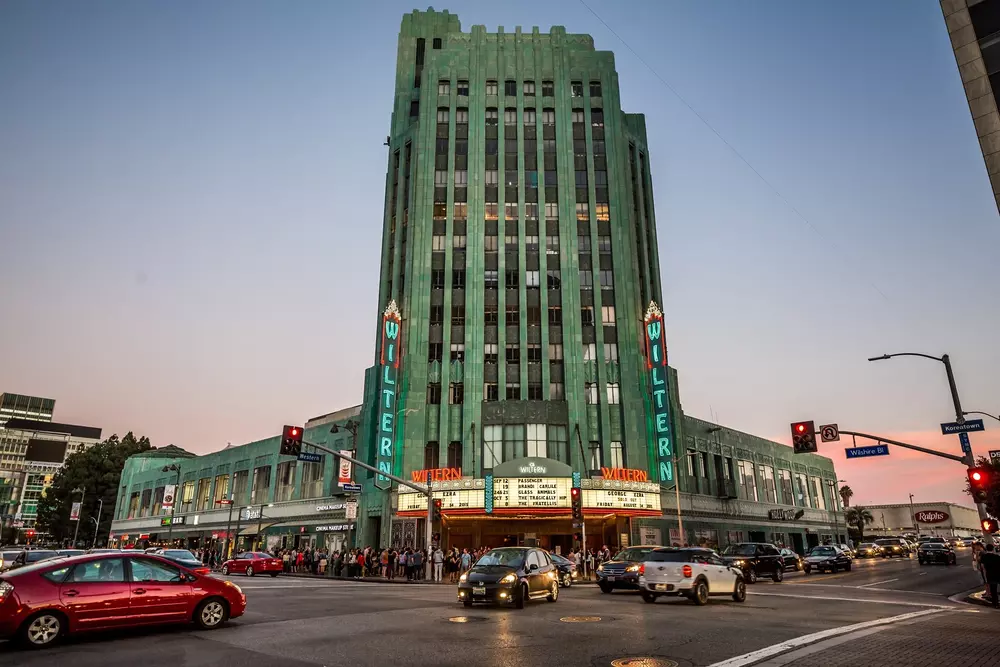The Wiltern Information
The Wiltern is located at the busy Southeast corner of Wilshire Boulevard and Western Avenue. California. The theater has a capacity of between 1200 to 4000 seats depending on the show and seating allocation.
In the last ten years the Wiltern also known as the Wiltern Theater and Wiltern center has been refurbished to accommodate larger audiences and bigger shows. The theater is split into 5 levels including a mezzanine area with two rear bars.
The Wiltern is used for many different events including: rock/pop concerts, dance performances, award shows, television tapings, stage productions, and corporate events. The large size allows for the flexibility of seating and capacity. The Wiltern offers a historical setting where it was originally opened in 1931 still retaining its Art Deco look and feel.

History
The venue started stunning audiences with epic shows almost nine decades ago. Originally constructed in 1931, the monument was designed by architect Stiles O. Clements from Morgan, Walls & Clements. This firm is considered one of the most renowned and oldest architectural companies in Los Angeles. Initially designed as a vaudeville theater, it debuted as the Warner Brothers Western Theater, serving as the flagship in their theater chain. After being closed for one year, the theater was reborn in the mid-1930s and rebranded as the Wiltern Theatre in honor of its impressive location (Wiltern is a combination of Wilshire and Western).
During its grand opening, The Wiltern housed the largest theater pipe organ in the whole of western United States! Its first night was a star-studded evening graced by movie pioneers Clark Gable, Joan Crawford, and James Cagney, who entered the venue through a specially constructed bridge, known as the “bridge of stars.”
And the magic hasn’t stopped since! In 1981, the developer Wayne Ratkovich bought The Wiltern and transformed the venue into an entertainment powerhouse. While originally designed and run as a movie theater, Ratkovich transformed it into a performing arts center capable of hosting live concerts and Broadway-level stage performances. This transformation involved opening up the rear wall and extending the stage and stage house of the theater by 15 feet. After a four-year renovation, The Wiltern reopened to the public in 1985 and featured performances by the Alvin Ailey American Dance Theater company.
What makes The Wiltern special?
Over the years, its amazing facilities have attracted a number of big players in the entertainment industry. During its early days of refurbishment, The Wiltern welcomed Hall of Fame musician Tom Petty, and it has continued to host legendary acts ever since!! From the multi-platinum-selling pop sensation Miley Cyrus and English rock icons Kasabian to the comedic brilliance of Amy Schumer and the electronic chart-topping duo The Chainsmokers – its lineup of awesome acts knows no bounds. The venue even became the stage for David Bowie and his impressive 28-song setlist in 2018 and Madonna with her iconic 10-night Madame-X tour in 2019!
As one of the largest theaters in Los Angeles, it’s clear why The Wiltern is a top choice for both artists and fans alike. In 2002, 1,200 permanent seats were removed from the ground floor, opening up possibilities for a variety of seating configurations. This allowed for everything from a standing-room-only crowd of 2,300 to a more intimate seated arrangement for 1,850 individuals. Meanwhile, the Loge and Mezzanine levels in the balcony continue to offer fixed theater seating, resulting in a total capacity of up to 4,000 seats.
In October 2018, Sugar Studios LA improved The Wiltern’s facilities even further by expanding its post-production capabilities on the 9th floor. They unveiled a versatile 25-seat Dolby Atmos mix stage and a state-of-the-art 4K color DI theater on the penthouse floor of the building.

Art Deco Architecture
Another thing that makes The Wiltern stand out is its beautiful design. It’s covered in blue-green tiles and sits at an angle to the street corner. Boasting a French Zig-Zag Moderne style, the venue is often considered one of the best examples of Art Deco architecture in the United States.
The building has two floors with stores on the bottom and tall, narrow windows that make it look much taller than it really is (buildings in LA were restricted from being higher than the city hall until the late fifties).
Upon entering The Wiltern, viewers are welcomed by big vertical neon signs. The ticket booth is set back and the floor is made of colorful terrazzo. Inside, the theater was designed by G. Albert Lansburgh, and is recognized for its Art Deco style with fancy plaster and tile work, alongside colorful murals painted by Anthony Heinsbergen. One aspect that really catches the eye is the sunburst on the auditorium’s ceiling. Each ray looks like a tall Art Deco skyscraper, showing what Lansburgh rightly thought the future of Wilshire Boulevard would be like – big and bright.
Who owns the venue?
Over the years, The Wiltern has been reimagined by a number of visionaries. Now, the building is owned privately, and the Wiltern Theatre is operated by Live Nation’s Los Angeles division.
